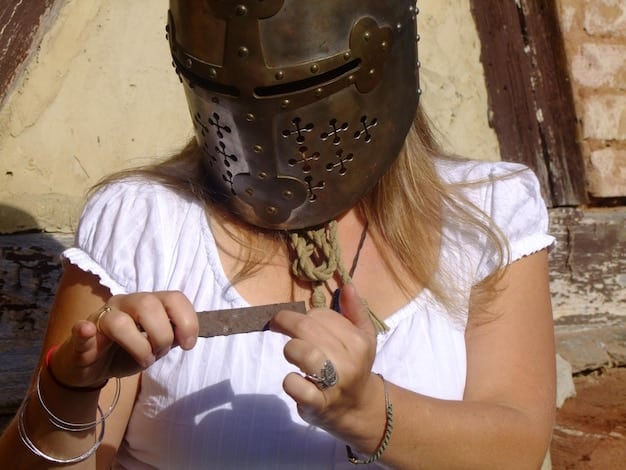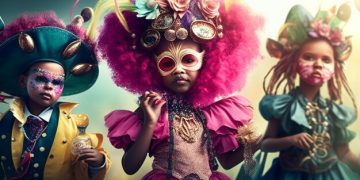The Ultimate Guide to Cosplay: Transforming into Your Favorite Characters

Cosplay, short for “costume play,” is a vibrant and creative subculture where enthusiasts craft and wear costumes to embody their favorite characters from video games, anime, comic books, movies, and more, often participating in conventions and photo shoots.
Dive into the world of cosplay, where imagination becomes reality. Learn how to bring your beloved characters to life with our comprehensive guide.
What is Cosplay? A Gateway to Fandom
Cosplay, or “costume play,” is more than just dressing up. It’s an art form, a hobby, and a way to connect with fellow fans. At its core, cosplay involves creating and wearing costumes to represent characters from various media.
But where did this fascinating pastime originate? And why is it so captivating to the millions who participate and admire it today?
The History of Cosplay
The roots of cosplay can be traced back to the early 20th century, with fans attending science fiction and fantasy conventions in homemade costumes. However, the modern concept of cosplay truly took shape in Japan during the 1970s and 1980s, driven by the growing popularity of anime and manga.
Japanese fans began creating elaborate costumes inspired by their favorite characters, showcasing them at conventions and events. This trend quickly spread globally, evolving into the diverse and multifaceted hobby we know today.
Why Cosplay Matters
Cosplay allows individuals to express their passion for specific characters and stories in a tangible way. It’s a creative outlet that encourages resourcefulness, skill-building, and community engagement. For many cosplayers, the joy lies in the process of crafting a costume, learning new skills, and sharing their creations with others.
- It fosters creativity and craftsmanship.
- It builds a sense of community among fans.
- It provides a platform for self-expression and confidence-building.
Cosplay empowers individuals to step outside their everyday lives and embody characters they admire, connecting with others who share their passions in a fun and engaging way.
In essence, cosplay isn’t just about wearing a costume; it’s about celebrating fandom, expressing creativity, and forging connections within a vibrant and supportive community.
Getting Started with Cosplay: First Steps
Embarking on your cosplay journey can seem daunting at first, but with a few simple steps, you can bring your favorite characters to life. It all starts with selecting the right character and planning your project.
So, how do you choose the ideal character for your first cosplay and create a roadmap for your costume creation?
Choosing Your Character
Selecting the right character is crucial for a successful and enjoyable cosplay experience. Consider factors such as your personal connection to the character, your skill level, and your budget. Start with characters you genuinely love and admire, as passion will fuel your motivation throughout the project.

For beginners, it’s often best to choose characters with simpler designs and readily available materials. Avoid overly complex costumes that require advanced techniques or expensive components. Prioritize characters that resonate with you and align with your current skills and resources.
Planning Your Cosplay Project
Once you’ve chosen your character, it’s time to plan your cosplay project in detail. Start by gathering reference images from various sources, including screenshots, promotional art, and fan-made costumes. Analyze the character’s design, paying close attention to the materials, construction techniques, and overall aesthetic.
Create a detailed budget that outlines the cost of materials, tools, and any potential commissions or outsourcing. Break down the project into manageable tasks, setting realistic deadlines for each stage. This will help you stay organized, avoid overwhelm, and track your progress effectively.
- Gather reference images.
- Create a detailed budget.
- Break down the project into manageable tasks.
Ultimately, planning is essential for a successful cosplay project. By carefully selecting your character and creating a detailed roadmap, you can set yourself up for a fun, rewarding, and confidence-boosting experience.
By carefully planning the project, the chance of frustration and failure is minimized, promoting a better experience.
Essential Cosplay Materials and Tools
Creating a stunning cosplay requires the right materials and tools. From fabrics and foams to paints and crafting implements, selecting the appropriate resources can significantly impact the quality and authenticity of your costume.
What are the must-have materials and tools for any aspiring cosplayer, and how can you use them effectively?
Fabrics and Textiles
Fabrics form the foundation of many cosplay costumes, providing the necessary shape, texture, and color. Common fabric choices include cotton, polyester, spandex, and various blends, each offering unique properties and applications. Consider factors such as durability, breathability, and ease of sewing when selecting fabrics for your project.
For intricate details and embellishments, consider using materials such as lace, ribbon, and embroidery thread. Experiment with different fabrics and textures to achieve the desired look and feel for your costume. Don’t be afraid to mix and match materials to create unique and visually appealing effects.
Foams and Armor
Foam is a versatile material often used for creating armor, props, and structural elements in cosplay costumes. EVA foam is a popular choice due to its lightweight, flexibility, and ease of shaping. Other foam options include craft foam, upholstery foam, and expanding foam, each suited for different applications.
When working with foam, be sure to use appropriate tools such as craft knives, heat guns, and contact cement. Learn basic techniques like cutting, shaping, and sealing to achieve professional-looking results. Experiment with different painting and finishing methods to create realistic textures and details.
Paints and Finishing
Paints are essential for adding color, detail, and realism to your cosplay creations. Acrylic paints are a versatile and widely used option, offering a wide range of colors and finishes. Other popular choices include spray paints, enamel paints, and specialty paints designed for specific materials.
- Select the right fabrics and textiles.
- Explore different foam types for armor.
- Master painting and finishing techniques.
Remember, the right materials and tools can transform your cosplay from ordinary to extraordinary. With careful planning, experimentation, and attention to detail, you can unleash your creativity and bring your favorite characters to life.
With the right tools, the possibilities are endless, and the costume’s final result will surely look amazing.
Crafting Techniques for Cosplay Beginners
Mastering basic crafting techniques is essential for any aspiring cosplayer. From sewing and pattern-making to armor fabrication and prop design, developing these skills will empower you to bring your imaginative visions to life.
So, what are the fundamental crafting techniques every beginner should learn, and how can you practice and improve these skills over time?
Sewing and Pattern-Making
Sewing is a core skill for creating fabric-based cosplay costumes. Start by learning basic hand-sewing techniques, such as running stitch, back stitch, and whip stitch. Familiarize yourself with sewing machines and learn how to thread, operate, and maintain them properly.
Pattern-making involves creating templates for your costume pieces, ensuring accurate fit and proportions. Start with simple patterns and gradually progress to more complex designs as your skills improve. There are many free patterns available online, catering to different characters and costume types.
Armor Fabrication
Armor fabrication involves creating protective and decorative armor pieces using materials like foam, plastic, and metal. Foam is a popular choice for beginners due to its affordability, versatility, and ease of shaping.
Start by creating templates for your armor pieces using paper or cardboard. Transfer the templates to your foam sheets and cut out the shapes using a craft knife or rotary cutter. Use a heat gun to shape and contour the foam, and secure the pieces together with contact cement or hot glue.

Prop Design and Creation
Props are essential accessories that enhance the visual impact and authenticity of your cosplay costumes. From weapons and shields to wands and accessories, props can add depth, character, and realism to your overall look.
Start by sketching your prop design, paying close attention to details such as size, shape, and materials. Choose appropriate materials based on your budget and skill level. Consider using materials like foam, wood, plastic, and metal, depending on the desired look and functionality.
- Master basic sewing techniques and pattern-making.
- Learn armor fabrication using foam and heat shaping.
- Design and create captivating props.
Learning crafting techniques are essential to improve the chance to make amazing costumes. With passion and dedication, even the most complex designs are possible.
By tackling projects, experimenting with new materials, and seeking guidance from experienced cosplayers, you can continuously refine your skills and elevate your cosplay creations to new heights.
Cosplay Makeup and Wig Styling
Cosplay makeup and wig styling are essential elements to complete your transformation into your chosen character. Mastering these techniques can significantly enhance your overall appearance and bring your cosplay to the next level.
What are the essential makeup and wig styling techniques every cosplayer should know, and how can you use them to create stunning and accurate character representations?
Cosplay Makeup Basics
Cosplay makeup involves using various cosmetic products and techniques to replicate the facial features, complexion, and expressions of your chosen character. Start by familiarizing yourself with basic makeup principles such as contouring, highlighting, and color correction.
Invest in high-quality makeup products that are suitable for your skin type and sensitive to cosplay applications. Consider using primers to create a smooth canvas, concealers to cover imperfections, and setting powders to lock in your makeup for long-lasting wear.
Wig Selection and Care
Wigs are essential accessories for many cosplay costumes, allowing you to replicate the hairstyle and color of your chosen character. When selecting a wig, consider factors such as fiber type, length, style, and color accuracy.
Synthetic wigs are a popular choice due to their affordability and versatility. They are available in a wide range of colors and styles and can be easily styled using heat tools such as hair dryers and curling irons. Human hair wigs offer a more natural look and feel but are generally more expensive and require more maintenance.
Styling Your Wig
Styling your wig involves cutting, shaping, and arranging the hair fibers to match the hairstyle of your chosen character. Start by brushing your wig to remove any tangles or knots. Use a wig stand to secure the wig while styling, and work in small sections to achieve the desired look.
When cutting your wig, use sharp scissors or a razor to create layers, bangs, or other stylistic elements. Use hairspray to hold the style in place, and avoid using excessive heat to prevent damage to the fibers. Experiment with different styling techniques to create unique and personalized looks.
- Learn cosplay makeup basics.
- Master wig selection and care.
- Practice wig styling techniques.
With dedication and practice, you unlock the ability to create stunning and accurate character representations.
By experimenting with colors, textures, and techniques, and by continuously learning and refining your skills, you can transform your appearance and immerse yourself fully in the world of cosplay.
Cosplay Etiquette and Convention Tips
Attending cosplay conventions is an exciting and rewarding experience, allowing you to showcase your creations, connect with fellow fans, and immerse yourself in a vibrant community. However, it’s essential to observe proper cosplay etiquette and follow convention guidelines to ensure a safe, enjoyable, and respectful environment for everyone.
What are the key principles of cosplay etiquette, and how can you navigate conventions with confidence and consideration for others?
Respect Personal Space
Respecting personal space is crucial in cosplay communities, as costumes can be restrictive and physically demanding. Always ask for permission before taking photos of cosplayers, and avoid touching their costumes or props without their consent.
Be mindful of your surroundings and avoid blocking pathways or creating congestion in high-traffic areas. If you need to stop for photos or engage in conversation, move to the side to allow others to pass freely. Remember that cosplayers may need to adjust their costumes or take breaks, so be patient and understanding.
Costume Guidelines
Most cosplay conventions have specific costume guidelines and regulations that cosplayers must adhere to. These guidelines typically address issues such as weapon safety, modesty, and prohibited items. Familiarize yourself with the rules and regulations of each convention you attend, and ensure that your costume complies with all requirements.
General Convention Tips
Attending cosplay conventions can be overwhelming, especially for first-time attendees. To ensure a smooth and enjoyable experience, plan ahead, stay hydrated, and prioritize your well-being. Wear comfortable footwear, bring a backpack to carry your essentials, and take breaks when needed.
- Respect personal space in cosplay communities
- Adhere to convention costume guidelines
- Plan ahead and prioritize your well-being at conventions.
Etiquette is essential because it makes for a mutually better overall experience for everyone involved.
By observing proper cosplay etiquette, adhering to convention guidelines, and prioritizing your well-being, you can navigate conventions with confidence, respect, and consideration for others, fostering a positive and inclusive environment for all.
| Key Point | Brief Description |
|---|---|
| 💡 Understanding Cosplay | Cosplay is a creative way to show love for characters and stories by crafting and wearing costumes. |
| ✅ Getting Started Tips | Choose a character you admire, plan your project, and gather references to make the best cosplay. |
| 🧵 Basic Materials | Fabrics, foams, and paints are essential. Select materials based on the desired texture and look for your costume. |
| 🎭 Cosplay Etiquette | Respect personal space, follow costume guidelines, and stay hydrated and comfortable at conventions. |
FAQ
▼
Cosplay is short for “costume play” where fans dress up as characters from various forms of media, like anime, video games, and comics. It allows for creative expression and celebrating favorite characters.
▼
Cosplay originated in Japan during the 1970s and 1980s, fueled by the growing popularity of anime and manga. It has spread globally and evolved into a diverse and creative hobby.
▼
Affordable and easy-to-use materials like EVA foam, cotton fabrics, and acrylic paints are great for beginner cosplayers. These materials provide a good balance of cost-effectiveness and versatility in crafting.
▼
Respect cosplayers’ personal space by asking for permission before taking photos. Always follow convention rules regarding costumes and behavior for a safe and inclusive environment.
▼
Practice consistently and try out simple designs. Seek guidance from online tutorials and more experienced cosplayers. Dedication and learning from experience builds and enhance skills over time.
Conclusion
Cosplay is an incredibly rewarding hobby where individuals can show love for their favorite characters and craft beautiful and cool-looking costumes. Getting involved is easy, just pick the right characters, plan ahead, and don’t be afraid to show yourself off. It does wonders for creativity, but also, helps build and grow communication and collaboration skills.





